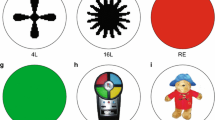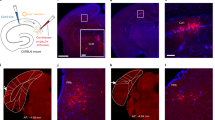Summary
This study examined correlates of memory processes in neuronal activity recorded from the substantia innominata, the diagonal band of Broca and the periventricular region or the basal forebrain of monkays performing recognition and/or visual discrimination tasks. Two types of neurons were found that responded differentially to stimuli on the basis of their novelty or their familiarity. Neurons (5/572) in the periventricular region rostral to the thalamus and caudal to the anterior commissure responded to familar stimuli with increases in firing rate. Neurons in the substantia innominata (16/ 1058) and in the diagonal band (14/489) responded maximally to novel stimuli, with smaller responses to repeared presentations of these stimuli. The properties of these two types of neurons were similar in three respects: (1) the magnitude of the differential response to novel and familiar presentations of stimuli were largest for stimuli presented on successive trials, and were attenuated for stimuli that had not been seen for some intervening trials; (2) both types of neurons responded to highly familiar stimuli as if they were novel if they had not been recently seen; (3) both types responded to two- and three-dimensional stimuli; and were recorded in rhesus monkeys trained on the recognition tasks and in untrained cynomolgus monkeys. An injection of HRP into the periventricular region of one monkey resulted in retrograde labeling of ventromedial regions of the prefrontal, cingulate and temporal cortices, of the amygdala, medial thalamus, supramammillary region of the midbrain. These data indicate that information about the novelty, familiarity or recency of presentation of visual stimuli is reflected in the responses of some basal forebrain neurons. Neurons in the substantia innominata and diagonal band of Broca could not be distinguished using the battery of applied tests, suggesting functional mechanisms common to both regions. The results of the anatomical experiment suggest that ventromedial limbic cortical and subcortical regions projecting to or through the periventricular region may be important for the transmission of information about visual stimuli and for memory function.
Similar content being viewed by others
References
Aggleton JP, Mishkin M (1983) Memory impairments following restricted medial thalamic lesions in monkeys. Exp Brain Res 52:199–209
Aggleton JP, Mishkin M (1984) Projections of the amygdala to the thalamus in the cynomolgus monkey. J Comp Neurol 222:56–68
Aigner T, Mitchell S, Aggleton JP, Delong M, Strubble R, Wenk G, Price D, Mishkin M (1984) Recognition deficit in monkeys following neurotoxic lesions of the basal forebrain. Soc Neurosci Abstr 10:116.11
Albert M, Moss M (1984) The assessment of memory disorders in patients with Alzheimer's disease. In: Squire LR, Butters N (eds) Neuropsychology of memory. Guildford Press, New York, pp 236–246
Alexander MP, Freedman M (1984) Amnesia after anterior communicating artery aneurysm rupture. Neurology 34:752–757
Angelergues R (1969) Memory disorders in neurological disease. In: Vinken PJ, Bruyn GW (eds) Handbook of clinical neurology, Vol 3. American Elsevier, New York, pp 268–292
Bachevalier J, Mishkin M (1986) Visual recognition impairment follows ventromedial but not dorsolateral prefrontal lesions in monkeys. Behav Brain Res 20:249–261
Brown MW, Wilson FAW, Riches IP (1987) Neuronal evidence that inferomedial temporal cortex is more important than hippocampus in certain processes underlying recognition memory. Brain Res 409:158–162
Bruning JL, Kintz BL (1977) Computational handbook of statistics, 2nd edn. Scott/Foresman, Glenview Illinois
Damasio AR, Graff-Radford NR, Eslinger PJ, Damasio H, Kassal N (1985) Amnesia following basal forebrain lesions. Arch Neurol 42:263–271
Dean RL, Bartus RT (1985) Animal models of geriatric cognitive dysfunction: evidence for an important cholinergic involvement. In: Traber J, Gispen WH (eds) Senile dementia of the Alzheimer type. Springer, Berlin, pp 269–282
Flicker C, Ferris SH, Crook T, Bartus RT, Reisberg B (1985) Cognitive function in normal aging and early dementia. In: Traber J, Gispen WH (eds) Senile dementia of the Alzheimer type. Springer, Berlin, pp 269–282
Friedman HM, Allen N (1969) Chronic effects of complete limbic lobe destruction in man. Neurology 19:679–689
Gascon GG, Gilles F (1973) Limbic dementia. J Neurol Neurosurg Psychiat 36:421–430
Geffen G, Walsh A, Simpson D, Jeeves M (1980) Comparison of the effects of transcortical and transcallosal removal of intraventricular tumours. Brain 103:773–788
Hanker JS, Yates PE, Meltz CB, Rustioni AJ (1977) A new specific, sensitive and non-carcinogenic reagent for the demonstration of horseradish peroxidase. Histochem J 9:789–792
Hedreen JC, Struble RG, Whitehouse PJ, Price DL (1984) Topography of the magnocellular basal forebrain system in human brain. J Neuropath Exp Neurol 43:1–21
Horel JA (1978) The neuroanatomy of amnesia: a critique of the hippocampal memory hypothesis. Brain 101:403–445
Horel JA, Pytko-Joiner DE, Voytko M, Salsbury K (1987) The performance of visual tasks while segments of the inferotemporal cortex are suppressed by cold. Behav Brain Res 23:29–42
Humphrey NK (1972) ‘interest’ and ‘pleasure’: two determinants of a monkey's visual preferences. Perception 1:395–416
Huppert FA, Piercy M (1978) The role of trace strength in recency and frequency judgements by amnesic and control subjects. QJ Exp Psych 30:347–354
Jones EG, Burton H, Saper CB, Swanson LW (1976) Midbrain, diencephalic and cortical relationships of the basal nucleus of Meynert and associated structures in primates. J Comp Neurol 167:385–420
Jürgens U, Müller-Preuss P (1977) Convergent projections of different limbic vocalisation areas in the squirrel monkey. Exp Brain Res 29:75–83
Kievit J, Kuypers HGJM (1975) Basal forebrain and hypothalmic connections to prefrontal and parietal cortex in the rhesus monkey. Science 187:660–662
Leichnetz GR, Astruc J (1977) The course of some prefrontal corticofugals to the pallidum, substantia innominata and amygdaloid complex in monkeys. Exp Neurol 54:104–109
Luria AR, Homskaya ED, Blinkov SM, Critchley McD (1967) Impaired selectivity of mental processes in association with a lesion of the frontal lobe. Neuropsychologia 5:105–117
Mahut H, Zola-Morgan S, Moss M (1982) Hippocampal resections impair associative learning and recognition memory in the monkey. J Neurosci 2:1214–1229
Mair WGP, Warrington EK, Weiskrantz L (1979) Memory disorder in Korsakoff's psychosis. Brain 102:749–783
Mesulam M-M, Mufson EJ, Levey AI, Wainer BH (1983) Cholinergic innervation of cortex by the basal forebrain: cytochemistry and cortical connections of the septal area, diagonal band nuclei, nucleus basalis (substantia innominata) and hypothalamus in the rhesus monkey. J Comp Neurol 214:170–197
Mesulam M-M, Mufson EJ (1984) Neural inputs into the nucleus basalis of the substantia innominata (CH4) in the rhesus monkey. Brain 107:257–274
Mishkin M (1978) Memory in monkeys severely impaired by combined but not separate removal of amygdala and hippocampus. Nature 273:297–299
Mishkin M (1982) A memory system in the monkey. Phil Trans R Soc Lond B298:89–95
Murray EA, Mishkin M (1984) Severe tactual as well as visual memory deficits follow combined removal of the amygdala and hippocampus in monkeys. J Neurosci 4:2565–2580
Murray EA, Mishkin M (1986) Visual recognition in monkeys following rhinal cortical ablations combined with either amygdalectomy or hippocampectomy. J Neurosci 6:1991–2003
Nichelli P, Baraldi A, Cappelli G (1982) Hypernaetremic thirst deficiency and memory disorders following hypothalamic lesions. Arch Psychiat Nervenkr 231:459–470
Parent A, DeBellefeuille L (1982) Organisation of efferent projections from the internal segment of the globus pallidus in the primate revealed by the fluorescence retrograde labeling method. Brain Res 245:201–213
Price JL, Amaral DG (1981) An autoradiographic study of the projections of the central nucleus of the monkey amygdala. J Neurosci 1:1242–1259
Rolls ET, Perrett DI, Caan AW, Wilson FAW (1982) Neuronal responses related to visual recognition. Brain 105:611–646
Russchen FT, Amaral DG, Price JL (1985) The afferent connections of the substantia innominata in the monkey, Macaca fascicularis. J Comp Neurol 242:1–27
Scoville WB, Milner B (1957) Loss of recent memory after bilateral hippocampal lesions. J Neurol Neurosurg Psychiat 20:11–22
Squire LR, Moore RY (1979) Dorsal thalamic lesion in a noted case of chronic memory dysfunction. Ann Neurol 6:503–506
Talland GA, Sweet WH, Ballantine Jr, TH (1967) Amnesic syndrome with anterior communication artery aneurysm. J Nerv Ment Dis 145:179–192
Taren JA (1965) Anatomical pathways related to the clinical findings in aneurysms of the anterior communicating artery J Neurol Neurosurg Psychiat 28:228–234
Van Buren JM, Borke RC (1972) The mesial temporal substratum of memory: anatomical studies in three individuals. Brain 95:599–632
Veazey RB, Amaral DG, Cowan WM (1982) The morphology and connections of the posterior hypothalamus in the cynomolgus monkey (Macaca fascicularis). 2. Efferent connections. J Comp Neurol 207:135–156
Volpe BT, Hirst W (1983) The characterisation of two patients with amnesia following the rupture and repair of anterior communicating artery aneurysm. J Neurol Neurosurg Psychiat 46:704–709
Wallesch CW, Kornhuber HH, Kollner C, Haas HC, Hufnagl JM (1983) Language and cognitive deficits from medial and dorsolateral frontal lobe lesions. Arch Psychiat Nervenkr 233:279–296
Whitehouse PJ, Price AW, Struble RG, Clark AW, Coyle JT, DeLong MR (1982) Alzheimer's disease and senile dementia: loss of neurons in the basal forebrain. Science 215:1237–1239
Whitlock DG, Nauta WJH (1956) Subcortical projections from the temporal neocortex in Macaca mulatta. J Comp Neurol 106:184–207
Williams M, Penneybacker J (1954) Memory disturbances in third ventricle tumours. J Neurol Neurosurg Psychiat 17:115–123
Wilson FAW, Rolls ET, Yaxley S, Thorpe SJ, Williams GV, Simpson SJ (1984) Responses of neurons in the basal forebrain of the behaving monkey. Soc Neurosci Abstr 10:37.8
Wilson FAW (1985) Neuronal activity related to novelty, familiarity and reinforcement. Ph D thesis. University of Oxford
Wilson FAW, Rolls ET (1987) Habituation and stimulus-specific neuronal responses recorded from the amygdala of the monkey. Soc Neurosci Abstr 17:305.6
Wilson FAW, Riches IP, Brown MW (1988) Neuronal activity in the inferomedial temporal cortex compared with that in the hippocampal formation: implications for amnesia of medial temporal lobe origin. In: Woody CD, Alkon DL, McGaugh JL (eds) Cellular mechanisms of conditioning and behavioral plasticity. Plenum Press, New York, pp 313–328
Winocur G, Oxbury S, Roberts R, Agnetti A, Davis C (1984) Amnesia in a patient with bilateral lesions to the thalamus. Neuropsychologia 22:123–143
Woodward RR, Goldsmith PL (1964) Cumulative sum techniques: mathematical and statistical techniques for industry. ICI monographs, no. 3. Oliver and Boyd, Edinburgh
Woody CD, Kim E, Berthier NE (1983) Effect of hypothalamic stimulation on unit responses recorded from neurons of sensorimotor cortex of awake cats during conditioning. J Neurophysiol 49:780–791
Zola-Morgan S, Squire LR (1985) Medial temporal lesions in monkeys impair memory on a variety of tasks sensitive to human amnesia. Behav Neurosci 99:22–34
Author information
Authors and Affiliations
Rights and permissions
About this article
Cite this article
Wilson, F.A.W., Rolls, E.T. Neuronal responses related to the novelty and familiarity of visual stimuli in the substantia innominata, diagonal band of Broca and periventricular region of the primate basal forebrain. Exp Brain Res 80, 104–120 (1990). https://doi.org/10.1007/BF00228852
Received:
Accepted:
Issue Date:
DOI: https://doi.org/10.1007/BF00228852




